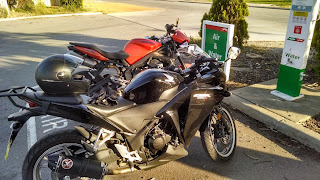Fairing swaps and more motorcycle pictures.

This weekend recently passed, I made the next step in motorcycle personalisation. I swapped the front fairing (the bit around the windscreen) and front wheel hugger (the bit over the front tyre). There's a lot of pictures of me pointing to screws and mountings. It may sound silly, but it really helped when everything was going back together. The biggest pain was the rubber grommet on the hugger. They didn't go in easily, and took at least an hour of fiddling around. The exhaust has also changed since the last picture. It has gone from a "Comp Werkes GP Race" to a "Comp Werkes GP". The sound is a great deal nicer than before, and it's a little bit quieter.
